Barrow-in-Furness Tramways
History
Although Barrow Corporation obtained powers for a tramway in the town as early as 1881, it subsequently decided against building a system itself, instead soliciting proposals from the private sector. Agreement was eventually reached with the Barrow-in-Furness Tramway Company Limited to construct and operate a 4ft 0ins-gauge steam tramway, the first services commencing on the 11th July 1885. The system comprised a central line along Duke St to Ramsden Square, with branches off this to the northeast (to Abbey), to the east (to Roose) and one southwestwards across Barrow Island to Ramsden Dock.
The tramway appears to have operated reasonably well for a number of years, but by the mid-1890s, it was clearly in trouble, with angry shareholders and much friction between the corporation and the company over the state of the engines and track, as well as irregular running. Matters did not improve, and on the 25th February 1896, the company entered liquidation. Although the corporation was offered the system on the 19th November 1898, it formally declined to purchase it, thus leaving the way open for the British Electric Traction Company Limited to acquire the company, a deal which they completed on the 23rd December 1899. At this time, the BETCo was aggressively purchasing horse and steam-operated tramways across the British Isles, with the intention of converting them to electric traction; however, for reasons which are now unclear, it took the BETCo over four years to achieve this goal in Barrow.
Meanwhile, the BETCo continued to run the ever-more decrepit steam trams — directly rather than through a subsidiary company, which was their preferred modus operandi — until disaster struck on the 27th June 1902 when a fire destroyed all bar two of the engines and half of the trailers, an event which unsurprisingly resulted in the suspension of services. Services were however resumed on the 8th August 1902, six days after the company had reached agreement with the corporation to convert the system to electric traction. The last steam tram ran on the 13th July 1903 and the first electric service on the 6th February 1904.
On the 4th August 1911, the company commenced services to Biggar Bank, an extension to the system owned by the corporation and leased to the company. This took the system to its final extent of 6.39 miles.
Like many other tramways across the British Isles, by the end of the Great War, the system was in very poor condition following four years of minimal maintenance and investment. The corporation came to the rescue, purchasing the tramway on the 1st January 1920; however, and in spite of its best efforts, including the purchase of many second-hand cars, the system continued to lose money. One accusation that could not be levelled at the corporation was inefficiency, as Barrow Tramways had the lowest operating costs of any system in the UK during the 1920s.
The corporation introduced its first bus service in 1923, expanding services slowly over the course of the next few years. The tipping point came in 1932 when a choice had to be made to either completely renew the tramway, which was life expired, or abandon it altogether. Unsurprisingly, the latter course of action was chosen, and the last trams ran on the 5th April 1932.
Uniforms
Steam engine drivers and stokers wore typical railway footplate attire, namely: cotton jackets and trousers, with grease-top or heavy cotton caps. Conductors may have worn uniforms in the earliest years (this is not clear), but were definitely issued with kepi-style caps that bore a large badge of unknown pattern (an example has not survived). By the mid-1890s however, conductors were definitely wearing informal attire — jackets and trousers, shirt and tie, along with the fashionable headgear of the day, usually the flat cap.
It seems highly likely that the BETCo continued the uniform policy of its predecessor — as far as steam services were concerned — only issuing uniforms once electric services commenced.
The BETCo, which operated Barrow Corporation Tramways from 1899 to 1920, was a concern which at its zenith either owned, part-owned or leased almost fifty tramways across the British Isles. The photos below clearly show Barrow tramway staff wearing the familiar and largely regulation BETCo uniform. Although jackets varied somewhat between systems, as well as across the decades, the cap badges, collar designations and buttons invariably followed a standard pattern.
Electric tramcar crews were initially issued with double-breasted jackets bearing five pairs of brass buttons (of the standard BETCo pattern — see link), three pockets with flap closures (two hip level and one waist level) and lapels; the collars appear to have carried embroidered, script-lettering system initials on both sides: BINFT. The tensioned-crown peaked caps bore the standard BETCo ‘Magnet & Wheel’ device badge (see below), beneath which an employee number (in individual brass numerals) was worn. Although the early studio portrait below shows an individual without an employee number, it is possible that they had not been issued at the time the photograph was taken.
The above uniform was quickly superseded by a more robust outfit: conductors were now issued with single-breasted jackets with five buttons, a single breast pocket (with button closure), and stand-up collars; the latter carried individual ‘B E T’ initials on the right-hand side — presumably standing for 'Barrow Electric Tramways' — and an employee number on the left-hand side, all brass. Motormen wore double-breasted, lancer-style tunics with five pairs of buttons (narrowing from top to bottom) and stand-up collars; the latter carried the same insignia as conductors' jacket collars. The caps and cap badges remained unchanged. At some point, and certainly by the time of the Great War, the collar initials had shrunk to 'B T' (i.e., Barrow Tramways).
In 1907, the company employed 34 motormen and conductors, with a solitary inspector (Barrow-in-Furness Transport; Ian L Cormack, 1977).
From around 1908 through to the Great War, tramcar staff wore round licence badges, presumably issued by Barrow Corporation, invariably suspended from the left breast of their tunics; it is currently unclear what information these badges bore. Long double-breasted greatcoats were also provided; these had five pairs of buttons and high fold-over collars: in the early years they bore embroidered, script-lettering system initials on both sides (BINFT), but in later years, they appear to have been left plain (i.e., unadorned). The later garments also bore epaulettes.
A wonderfully detailed depot photograph has survived from the Great War (see below), which shows staff wearing a motley assortment of uniforms and insignia, including numerous regimental badges. This was common practice amongst tramway staff during the Great War, presumably either to mark military service rendered, or to show support for a close family member or partner (in the case of female employees) who was on active service. The photograph also includes two trolley boys, who were employed during the Great War to assist the conductresses with heavily loaded cars.
Whilst the uniforms do not appear to have changed substantially in style following the corporation take-over, photographs clearly reveal that a large round cap badge was worn from 1920 onwards; this was almost certainly the same pattern as used in the later 'Corporation Transport' era, and featured a municipal device within a wreath (see below).
Inspectors wore standard BETCo uniforms, which comprised single-breasted jackets with hidden buttons (or more likely hook and eye fasteners); the jackets were edged in a finer material than the main body of the jacket, with the collars bearing either Inspector or Traffic Inspector in embroidered script lettering. The tensioned-crown peaked caps bore the grade — Inspector — in embroidered script lettering on a hat band. Inspectors were also provided with double-breasted overcoats bearing lapels, the collars of which carried the designation Traffic Inspector in embroidered script lettering. By the time of the Great War, Barrow Tramways employed the services of a Chief Inspector; his uniform was essentially identical to those worn by inspectors, but with the grade Chief Inspector rather than Inspector.
In common with many other British tramway systems, women were employed during the Great War, initially as conductresses, but also as motorwomen and inspectresses. Female staff initially wore makeshift uniforms, along with long overcoats and whatever headgear was to hand; the latter were often adorned with regimental badges. Eventually, smart, tailored uniforms were provided by the company; these comprised long, single-breasted jackets bearing five buttons, a waist belt and two hip-level pockets, along with matching skirts. The jackets do not appear to have carried any insignia. Two types of headwear are known: dark-coloured straw bonnets (presumably for summer use) and baggy peaked caps, sometimes called motor caps (for winter use); both bore the standard BETCo ‘Magnet & Wheel’ cap badge. Female staff were also provided with smart, single-breasted top coats bearing buttons that were offset to one side. These coats were tailored; they had a broad waist belt carrying two buttons, large hip-level pockets and epaulettes. Unlike most other English tramway systems, female staff appear to have carried on working until at least 1920.
Barrow also employed the services of inspectresses, who appear, at least initially to have worn long overcoats (probably because uniforms were yet to be issued), along with a baggy cap (with glossy peak) bearing an Inspector badge in embroidered script lettering (see below).
Further reading
For more information on Barrow's tramways, see: 'Seventy-Five Years on Wheels' by Ian L Cormack; The Scottish Tramway Museum Society (1960).
Images
Steam tram drivers and conductors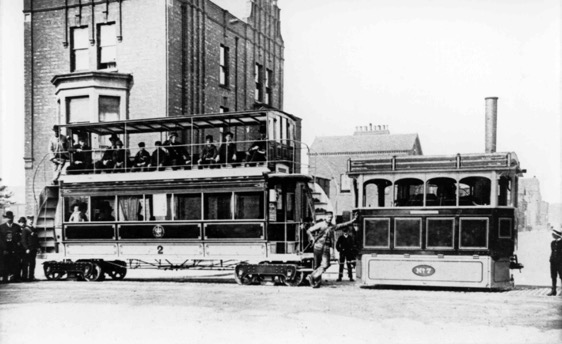
What looks to be a brand-new Kitson engine (No 7) and Falcon trailer (No 2) standing at the junction of Abbey Rd and Hartington St. Although the photograph is undated, the pristine condition of the vehicles strongly suggests that the shot was taken on the opening day, 11th July 1885. Photo from the R Corlett Collection, courtesy of Peter Holmes.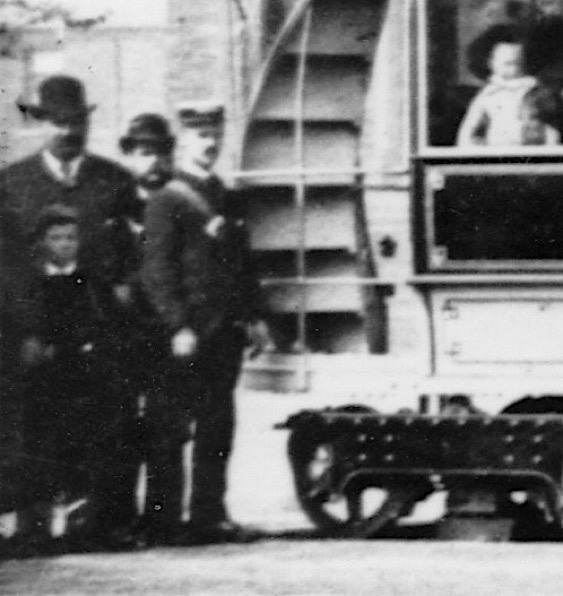
An enlargement of the above photograph showing the conductor, who is wearing smart attire — possibly a uniform — and a kepi-style cap bearing a large cap badge.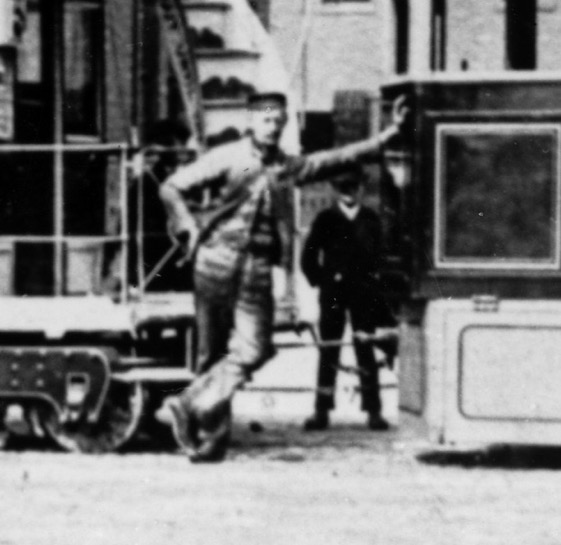
Another enlargement of the photograph above, this time showing the driver, possibly William Parsons, who is wearing fairly typical steam-footplate attire.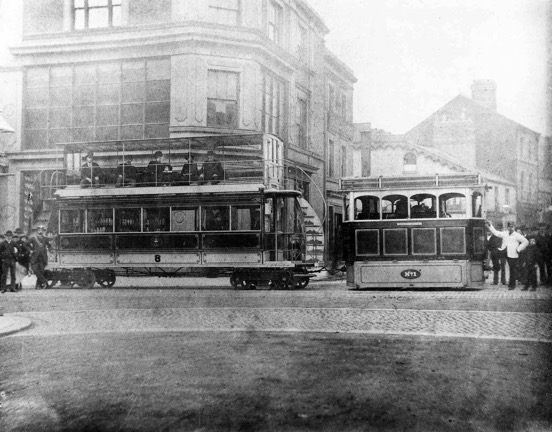
Another photograph taken on what was in all probability, the opening day, but this time in Duke St. The subjects are Engine No 1 and Trailer No 8. Photo courtesy of David Gladwin, with thanks to Trevor Preece; the whereabouts of the original are unknown.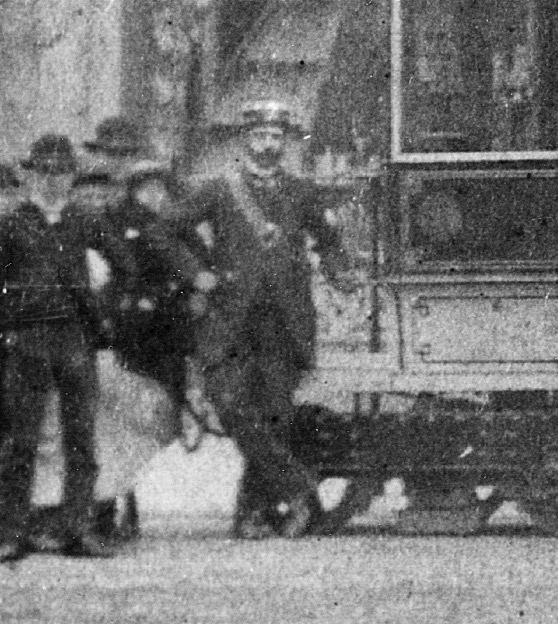
An enlargement of the above photograph showing the conductor. Whilst it is unclear whether he is wearing a uniform, he definitely has what is almost certainly a company-issued kepi-style cap, which possibly bears a cap badge.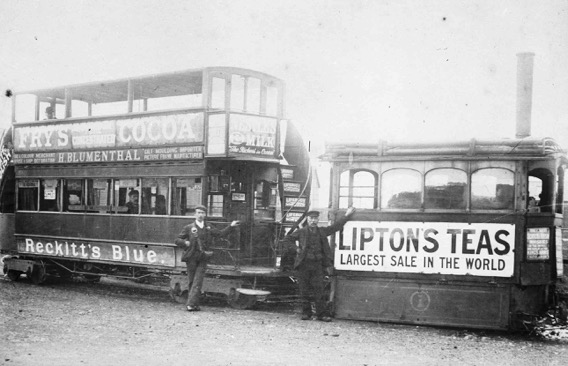
A conductor and a driver pose with Kitson-built Steam Tram No 1 and Falcon-built trailer — photo undated, but probably taken in the mid-1890s given that the engine and trailer are in relatively good condition. With thanks to the National Tramway Museum.
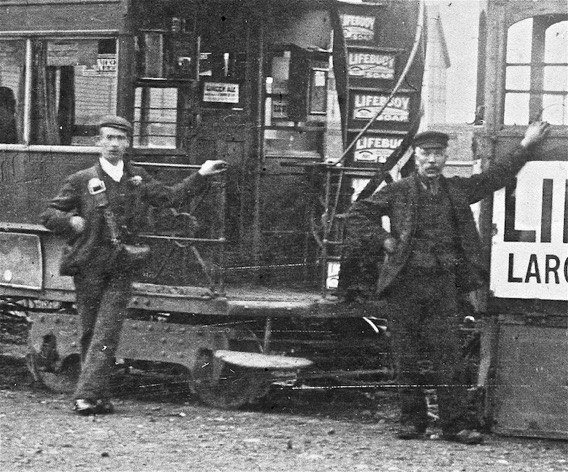
An enlargement of the above photograph showing the crew, both of whom are wearing informal attire. The driver is very probably Mr William Parsons, who purportedly drove the first steam tram.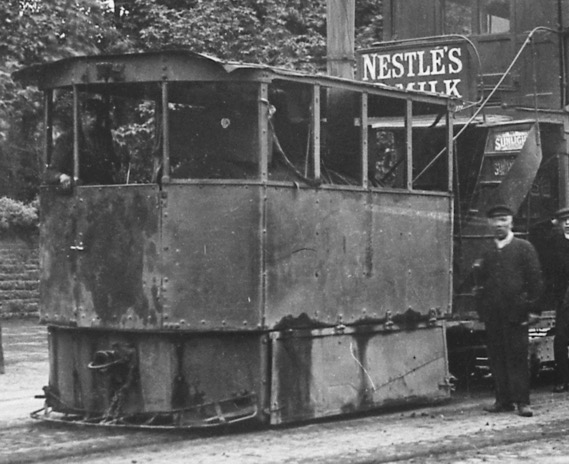
An extremely battered-looking steam tram, more than likely one of the fire-damaged Kitsons, with driver and fireman in Abbey Road — photo undated, but probably taken in 1903, some four years after the BETCo takeover. There is reason to believe that the scene is posed, as the engine appears not to be in steam and its condition would preclude its use on public roads. The individual standing on the right could well be William Parsons. Photo courtesy of the Tramways and Light Railway Society, with thanks to David Voice.
Motormen and conductors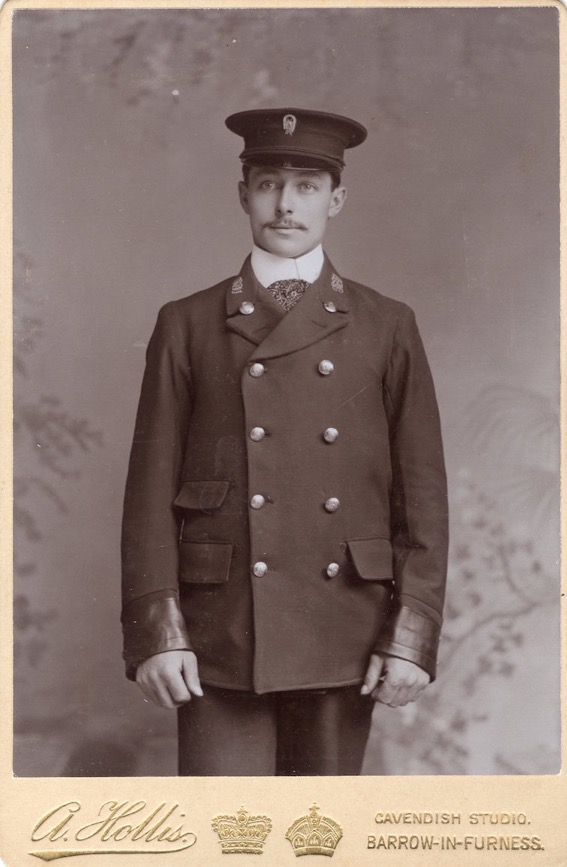
A pristine studio portrait of a Barrow-in-Furness Tramways employee — photo undated, but very likely taken to mark the inauguration of the electric services (1904). Arthur Hollis was a photographer to royalty — hence the crowns — and the quality certainly bears testament to his talent (with thanks to Geoff Holme for the background information). Author's Collection.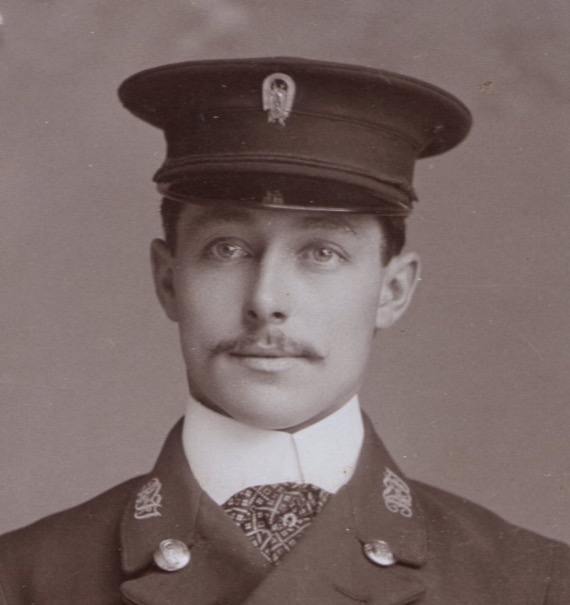
An enlargement of the above photograph showing details of the cap and collar insignia; the former bears the standard British Electric Traction Company 'Magnet & Wheel' cap badge, though without an employee number, whereas the latter appear to be BINFT script initials (embroidered). The photograph is so sharp, that the standard pattern BETCo buttons are easily made out.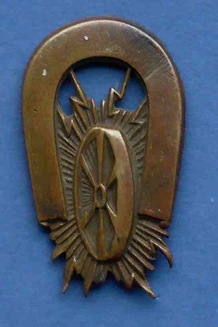
Standard British Electric Traction Company ‘Magnet & Wheel’ cap badge of the type used by Barrow-in-Furness Tramways — brass. Author's Collection.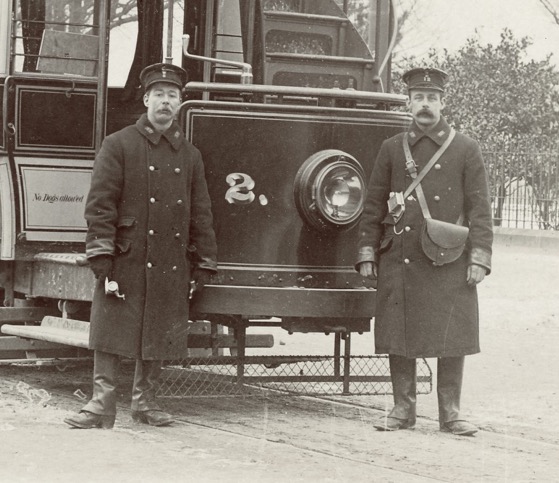
A motorman (No 8) and a conductor (No 12) at the Abbey Terminus with what would appear to be a virtually brand new Tramcar No 2 — photo undated, but thought to have been taken around February 1904. Photo by W Cookson, courtesy of the Peter Holmes Collection.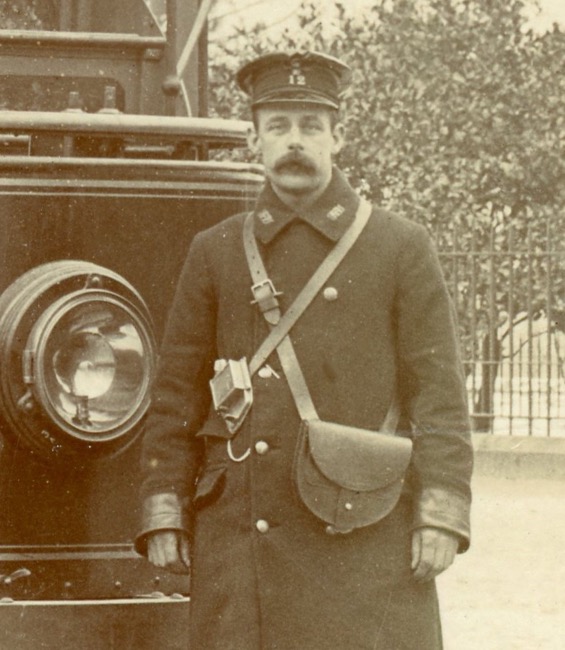
An enlargement of the above photograph showing details of the cap and greatcoat collar insignia. The collars would appear to bear embroidered system initials, BinFT.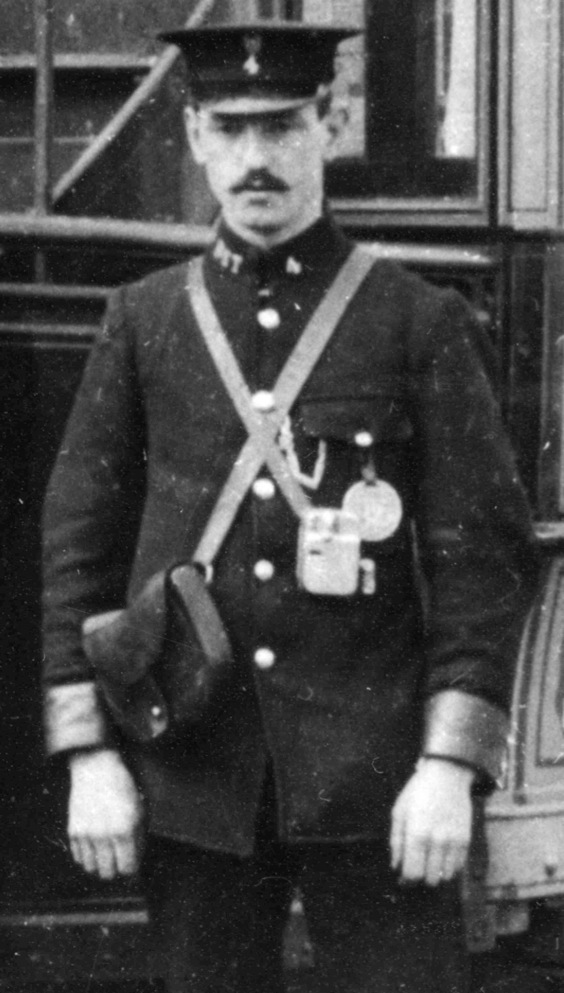
Conductor No 4 — date uncertain, but probably late Edwardian. The collar initials are now brass 'B E T' letters, presumably standing for Barrow Electric Tramways. The cap bears the standard 'Magnet and Wheel' device badge, worn above an employee number. A municipal licence badge is suspended from the button of his jacket pocket. Photo courtesy of the Geoff Holme Collection.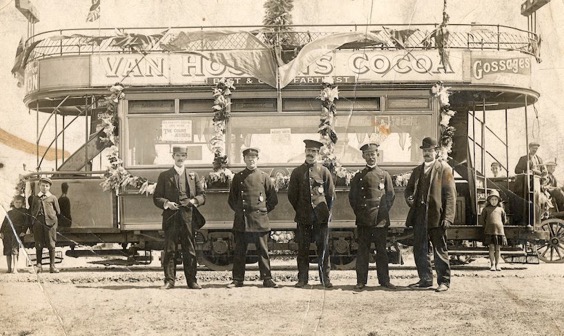
A conductor flanked by two motormen, with an unidentified decorated tram — photo undated, but judging by the condition of the tram and the fashions on display, probably mid-to-late Edwardian. Author's Collection.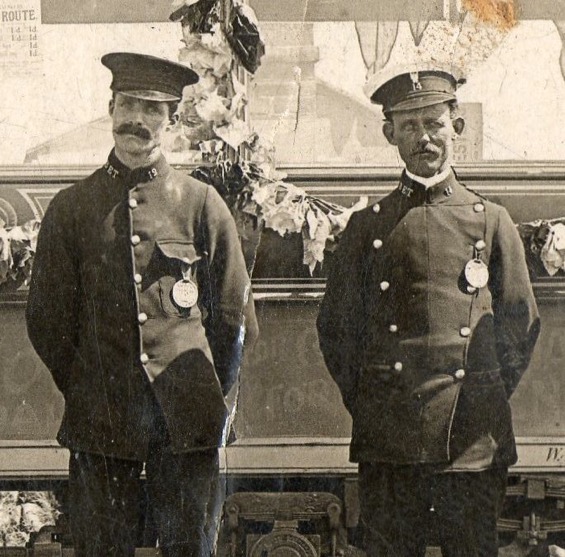
An enlargement of the above photograph showing the conductor (Employee No 12) and one of the motormen (Employee No 14). The other motorman (out of shot) is Employee No 3.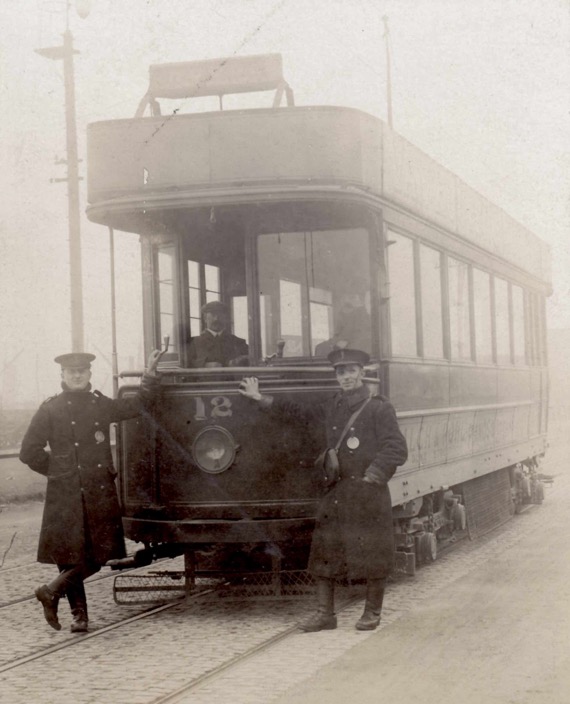
A motorman and conductor with Tram No 12, probably at Ramsden Dock — photo undated, but likely to have been taken in between 1908 and the Great War. Photo courtesy of the Geoff Holme Collection.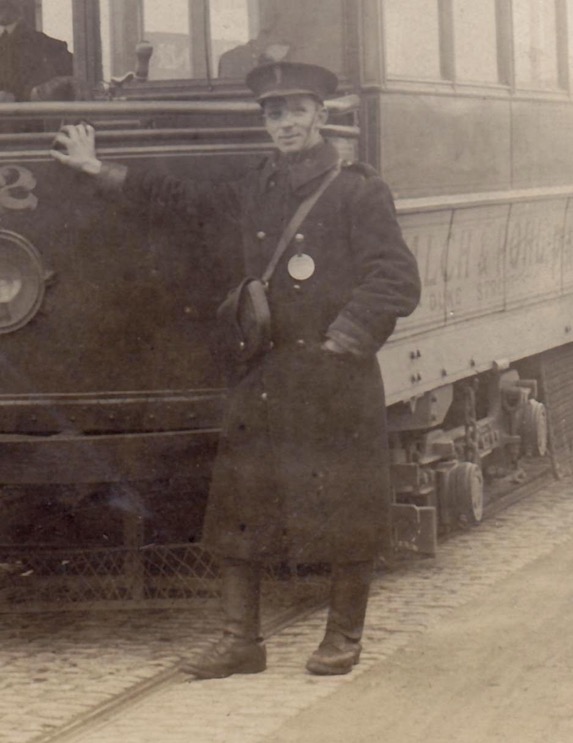
An enlargement of the above photograph showing the conductor, who is wearing a greatcoat with epaulettes, devoid of insignia, as well as a municipal licence badge.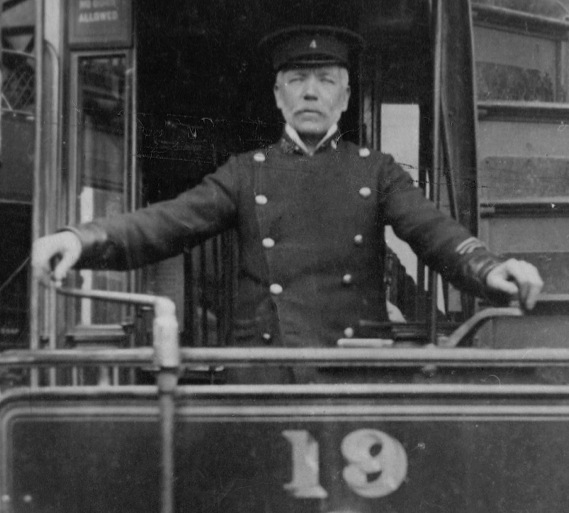
Motorman No 4 (William Parsons) at the controls of Tramcar No 19 bound for Amphitrite Street — photo undated, but probably taken in the second decade after electrification. The employee number is identical to that borne by the conductor above, suggesting that they may have been grade numbers rather than employee numbers. Note the absence of the standard BETCo ‘Magnet & Wheel’ cap badge, which is clearly seen in many other photos. The three stripes on the left sleeve probably denoted long service. Author's Collection.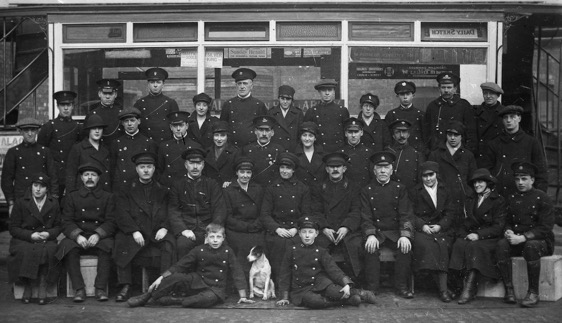
A staff photo taken at the Salthouse Depot — photo undated, but almost certainly taken during the Great War in view of the number of female staff and the plethora of regimental badges. With thanks to the National Tramway Museum. 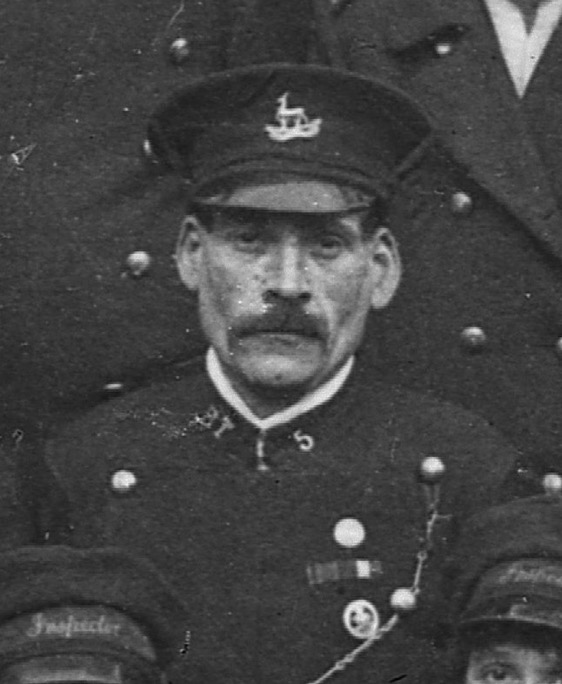
An enlargement of the above photograph showing Employee No 5; the system initials are now simply 'B T' rather than the earlier 'B E T'. The subject has a medal ribbon on his left breast, as well as a Silver War Badge, indicating that he had been honourably discharged due to wounds or illness. Like many in this photograph, his cap badge is actually an army badge, probably the Royal Warwickshire Regiment.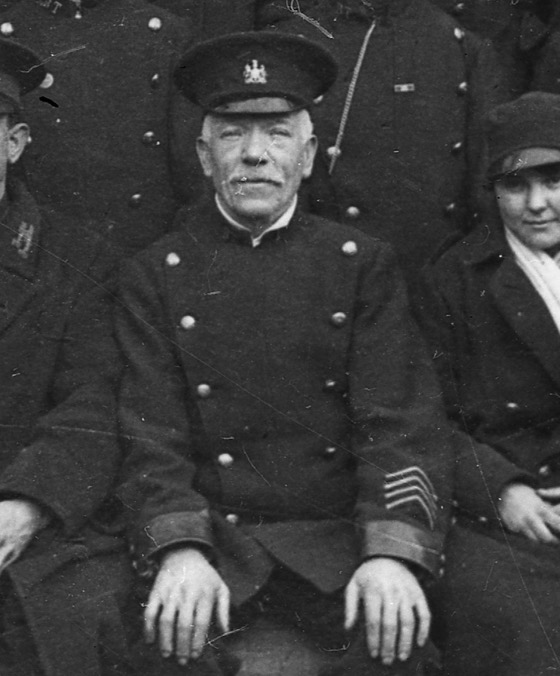
Another enlargement of the staff photo above showing Motorman William Parsons, who is also seen at the controls of Tramcar No 19 (above), as well as in at least two photographs of steam trams (see above). He now has four chevrons on his sleeve rather than the three he appears to have had in the earlier photo (of No 19). His cap appears to bear a General Service Corps badge, which he would have been wearing to show his support for a serving family member. If he did really drive the first steam tram in 1885, then he was probably in his late 50s in this photo. My thanks to Peter Holmes for the background information.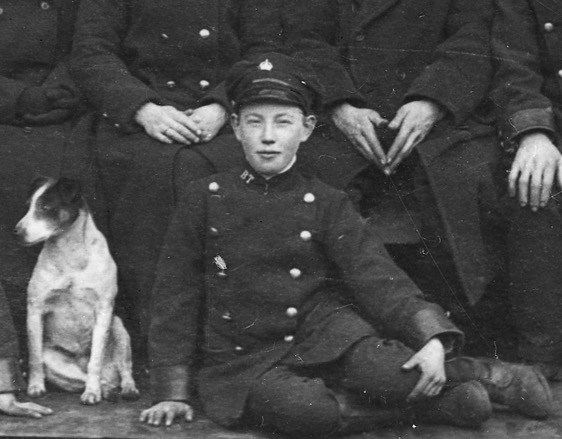
A trolley boy along with the depot dog (?), taken from the Great War staff photo above.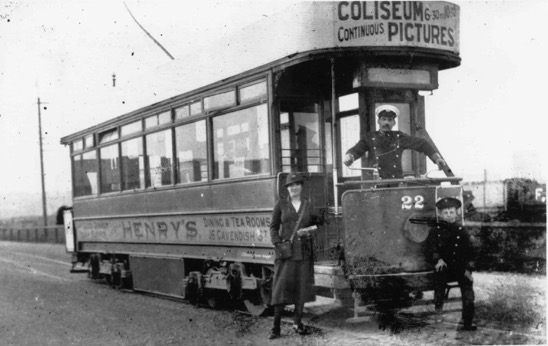
Tramcar No 22 stands at Ramsden Dock — photo undated, but almost certainly taken in the Great War or shortly thereafter. Photo courtesy of the Geoff Holme Collection.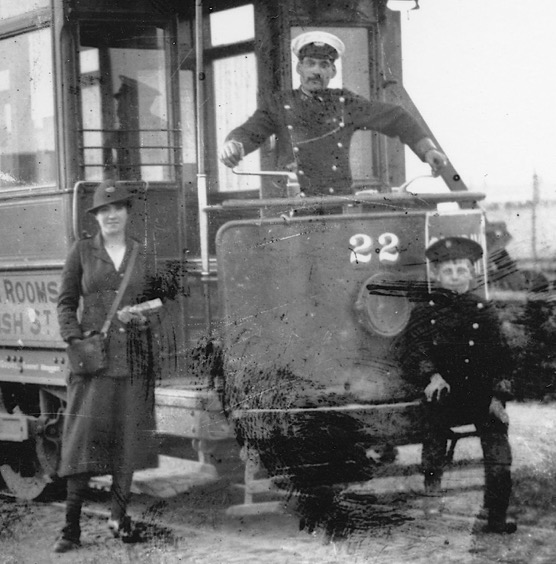
An enlargement of the above photograph showing the conductress, motorman and trolley boy. All three are on the staff photo above: the conductress in the middle row, second from left; the motorman in the middle row, sixth from the left (Employee No 5); and the trolley boy on the floor at the front left. 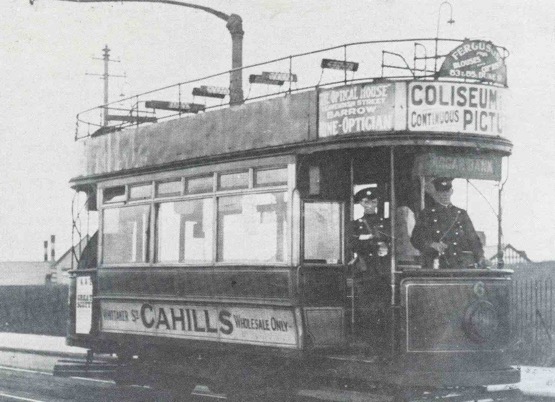
The crew of Tramcar No 6 pose for the camera in Amphitrite Street — photo undated, but probably taken in the mid-to-late 1920s. Although of poor quality, it does show the new municipal cap badge. Photo courtesy of the Ian L Cormack Collection, with thanks to Peter Holmes.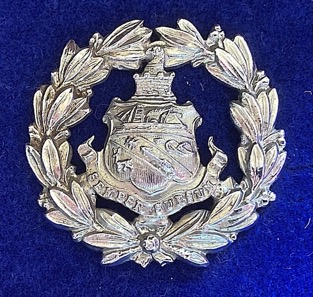
Barrow-in-Furness municipal-device badge — chrome. It is likely that a very similar pattern of badge was worn on tramcar crew caps during the corporation tramway era (1920-1932), but in either brass or nickel rather than chrome. Author's Collection.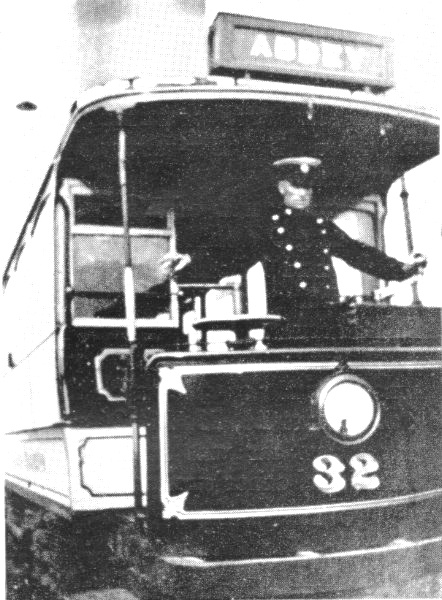
A poor quality photograph, but one which confirms that a large round cap badge was worn in the corporation era. No 32 was obtained from Sheffield Corporation in 1924, so the photo can have been taken no earlier than this date. Photo courtesy of the Tramways and Light Railway Society, with thanks to David Voice.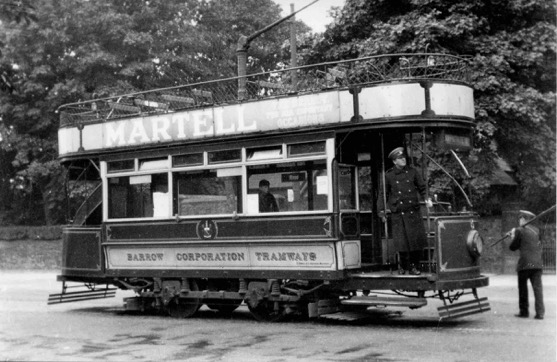
The motorman of Tramcar No 5 gazes into the distance whilst his conductor heads off around the vehicle, trolley reversing pole in hand — photo by Dr H A Whitcombe, taken in 1929. Photo courtesy of the Peter Holmes Collection.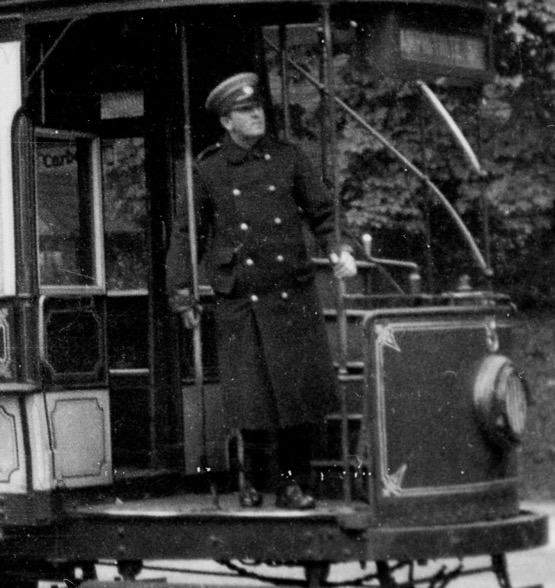
An enlargement of the above photograph showing the motorman; he is wearing the round corporation device badge on his cap.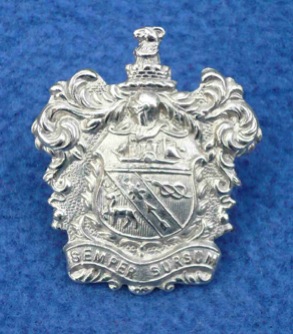
Barrow municipal device badge — nickel. It is unclear whether this was worn during the tram era. Author's Collection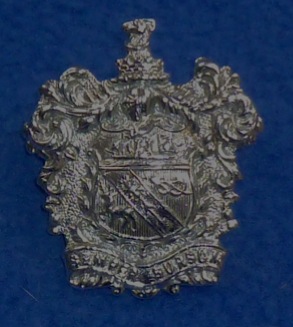
Barrow municipal device badge — chrome. Chrome badges would not have been worn during the tramway era as the system was closed prior to the introduction of chromium plating for badges (see link). Author's Collection.
Senior staff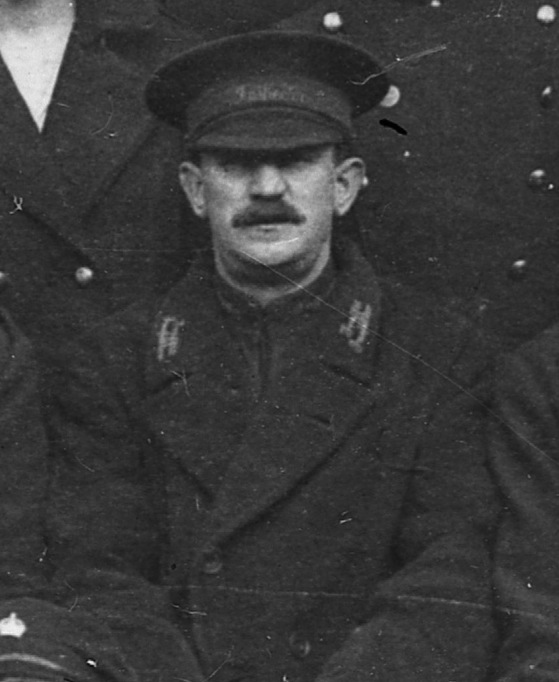
An enlargement of the Great War staff photograph above showing an inspector. His stand-up collars appear to bear Inspector in embroidered script-lettering, as does the hat band on his cap, whereas his overcoat collars bear the grade Traffic Inspector.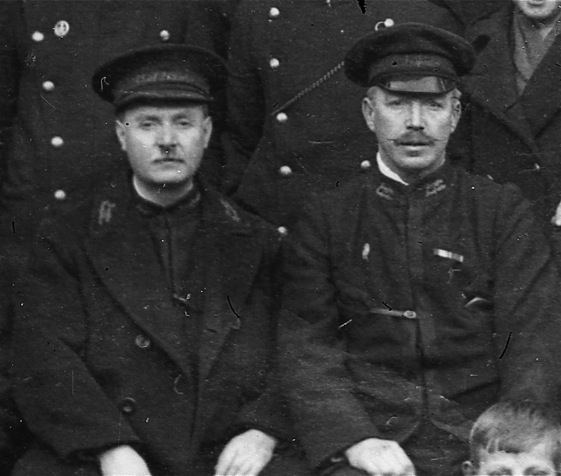
Another enlargement of the staff photograh above showing two senior members of staff. The man on the left appears to be the Chief Inspector, the man on the right a Traffic Inspector.
Female staff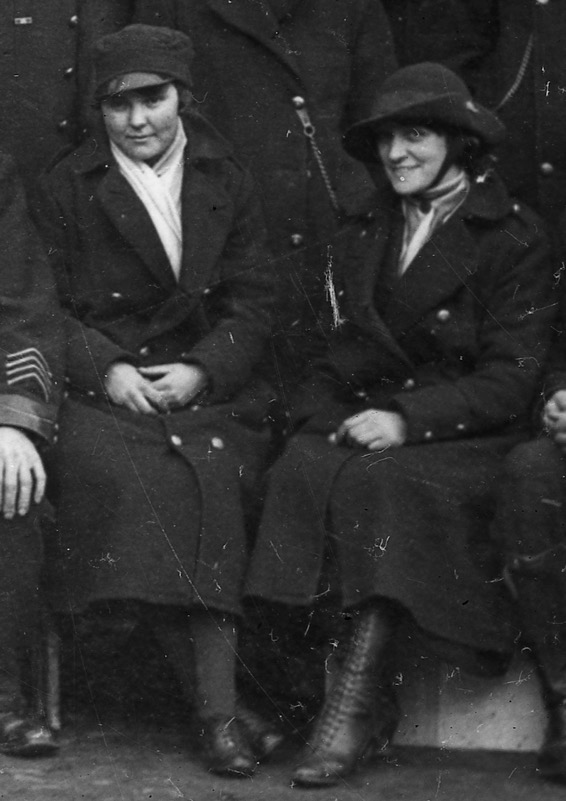
An enlargement of the staff photograph above showing two female employees. Most of the ladies present, including these two, appear to be wearing makeshift uniforms, suggesting that the tailored uniforms that were subsequently worn by female staff had yet to be delivered.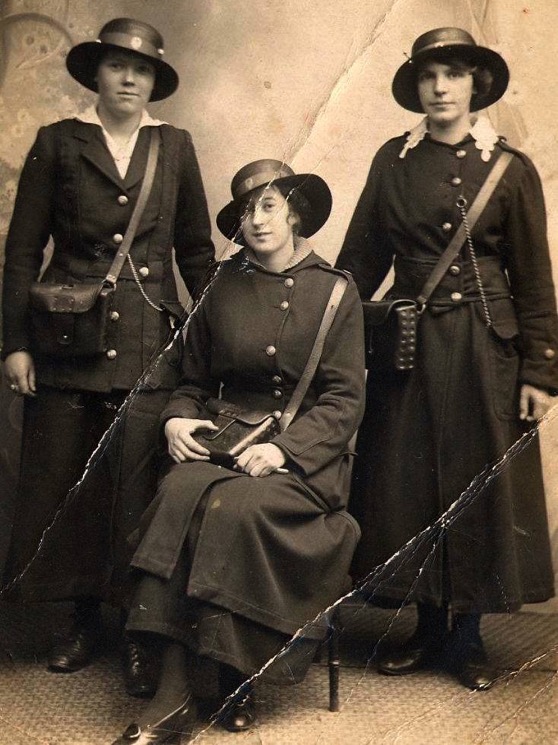
A studio portrait (by Priest of Barrow) of three Barrow Tramways conductresses in smart, tailored uniforms, making a stark contrast with the previous shot — photo undated, but almost certainly taken during the Great War. The dark-coloured straw bonnets bear the BETCo's ‘Magnet & Wheel’ cap badge. Photo courtesy of the Geoff Holme Collection.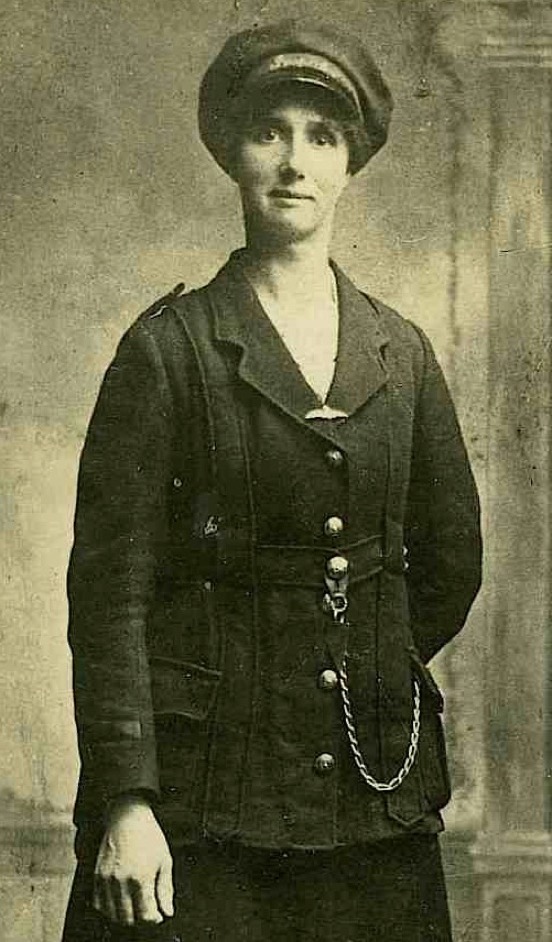
Motorwoman Annie Wilkinson — photo undated, but almost certainly taken during the Great War. She is wearing an embroidered Inspector cap badge, suggesting that she was an Inspector (or at least acting as one) when this photo was taken. The BETCo ‘Magnet & Wheel’ buttons can clearly be discerned on magnification. Photo reproduced with kind permission of The Dock Museum, Barrow-in-Furness (see link).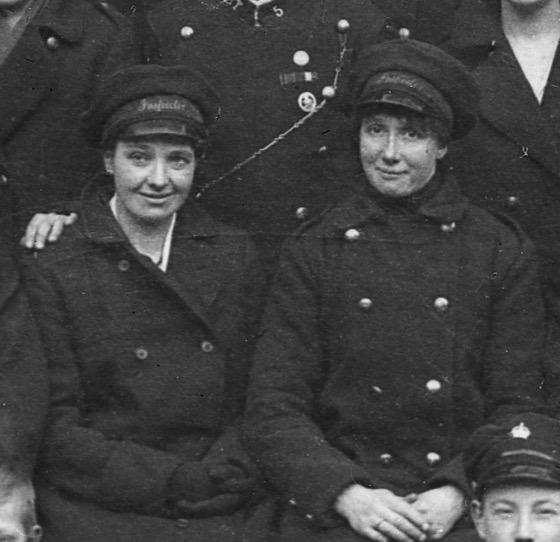
Another shot of Annie Wilkinson (right), along with an unidentified inspectress, this time taken from the staff photo above.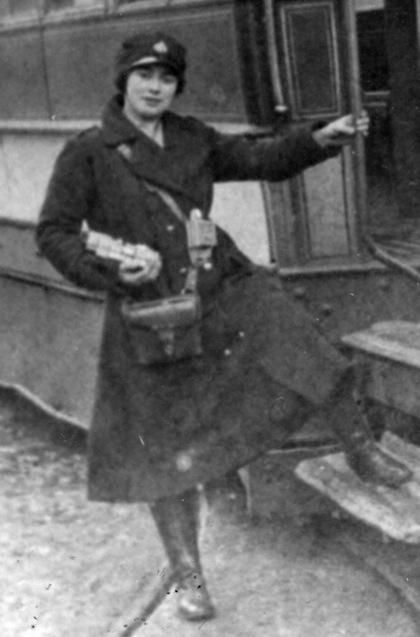
A conductress aboard Tramcar No 17 — photo undated, but probably taken in 1920. Photo courtesy of the Geoff Holme Collection.